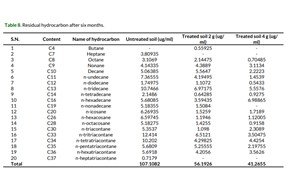Bioremediation of artificially crude oil polluted soil of veritas University Abuja using poultry manure
Abstract
The removal of hydrocarbon compounds from the environment has always been a difficult undertaking for people all over the world. As a result, remedial efforts are required to safeguard the environment as well as to restore agriculture. This study looked at how poultry manure (dung) could help in the bioremediation of Veritas University's intentionally crude oil polluted soil. The physical properties of the soil and total petroleum hydrocarbon content of the crude oil polluted soil were determined, followed by the isolation and identification of microorganisms present in the soil and poultry manure before and after pollution with crude oil. These analyses were done according to standard operating procedures. Within a six-month timeframe, the natural attenuation and poultry manure amendment option for remediating the crude oil-polluted soil were monitored and the residual hydrocarbon content of the polluted soil after remediation evaluated. There was an overall decrease in pH level during the experimental units containing 4 g amendment, 2 g amendment and the untreated polluted soil in the order 8.4 to 7.1, 8.4 to 7.2 and 8.1 to 6.7, respectively. Temperature was within 27oC and 31oC, the treated soil that contained 4 g dung had an initial moisture content of 58%, and 35% after remediation. The hydrocarbon utilizing bacteria isolated were Pseudomonas species, Staphylococcus species, and Bacillus species, while the hydrocarbon utilizing fungi isolated were Aspergillus niger, Fusarium solani and Candida albicans. There was more significant microbial increase in the sample containing 4 g poultry manure treatment than 2 g poultry manure treatment and natural attenuation. Total hydrocarbon quantity significantly decreased after six months with the complete removal of C4, C7, C19 and C37 from the treated sample containing 4 g poultry manure. This indicated that the negative effects of crude oil on the environment can be mitigated by adding poultry manure.
Keywords:
Bacteria, Bioremediation, Fungi, Poultry manureDownloads
References
Abatenh, E., Gizaw, B., Tsegaye, Z., & Wassie, M. (2017). The Role of Microorganisms in Bioremediation – A Review. Open Journal of Environmental Biology, 2 (1), 38-40.
Abha S., Vinay, K., & Srivastava, J. (2013). Assessment of Bioremediation of Oil and Phenol Contents in Refinery Waste Water via Bacterial Consortium. Journal of Petroleum and Environmental Biotechnology, 4, 145.
Adams, G., Fufeyin, P. T., Igelenyah, E., & Odukoya, E. (2014). Assessment of Heavy Metals Bioremediation Potential of Microbial Consortia from Poultry Litter and Spent Oil Contaminated Site. International Journal of Environmental Bioremediation and Biodegradation, 2(2), 84-92.
Blystone, J., Pelzner, A., & Steffens, G. (2001). Bureau of Public Roads. Highways research engineers. www.rhd.gov.bd
Burghal, A., Najwa, M., & Al-Tamimi, W. (2016). Mycodegradation of crude oil by fungal species isolated from petroleum contaminated soil. International
Journal of Innovative Research in Science, Engineering and Technology, 5(2), 1517-1524.
Cheesbrough, M. (2010). District Laboratory Practise in Tropical Countries. Part 2. 2ndedn. Cambridge University Press. South Africa. pp. 434.
Godleads, O. A, Prekeyi, T. F, & Samson, E. O. (2015). Bioremediation, Biostimulation and Bioaugmention: A Review. International Journal of Environmental Bioremediation & Biodegradation, 3(1), 28–39.
Hidayat, A., & Tachibana, S. (2012). Biodegradation of aliphatic hydrocarbon in three types of crude oil by Fusarium species F092 under stress with artificial sea water. Journal of Environmental Science and Technology, 5(1), 64-73.
Kensa, V. M. (2011). Bioremediation – An Overview. Department of Botany, S.T. Hindu College, Nagercoil, Tamil Nadu, India. Journal of Industrial Pollution Control. https://www.icontrolpollution.com/ArchiveICP/currentissue-
Modupe, E. O., Okeniyi, J. O., Okeniyi, E. T., Ikotun, J. O., Ejemen, V. A., & Akinlabi, E. T. (2018a). Bioremediation: Data on biologically mediated remediation of crude oil (Escravos Light) polluted soil using Aspergillus niger. Chemical Data Collections, 17, http://doi.org/10.1016/j.cdc.2018.09.002
Modupe, E. O., Okeniyi, J. O., Okeniyi, E. T., Ikotun, J. O., Ejemen, V. A., & Idowu Popoola, A. P. (2018b). Bioremediation: Data on Pseudomonas aeruginosa effects on the bioremediation of crude oil polluted soil. Data in Brief, 19, 101-113.
Okonokhua, B. O., Ikhajiagbe, B., Anoliefo, G. O., & Emede. (2007). The Effects of Spent Engine Oil on Soil Properties and Growth of Maize (Zea mays L.). Journal of Applied Sciences and Environmental Management, 11(3), 147-152.
Onuorah, S. C., Obika, I. E, Okafor, U. C., Okafor, O. I., Orji, M. U., & Udemezue, O. I. (2014). Preliminary Screening of Hydrocarbon-Utilizing Fungi Isolated from Dry Chicken Excreta in Ifite-Awka, Anambra State. International Journal of Advanced Scientific and Technical Research, 5(4), 43-51.
Pawar, R. M. (2015). The effect of soil pH on bioremediation of polycyclic aromatic hydrocarbons (PAHS). Journal of Bioremediation and Biodegradation, 6, 291.
Schumacher, B. A. (2002). Methods for the determination of Total Organic Carbon (TOC) in soils and sediments, pp. 1-23.
Shabir, G., Afzal, M., Anwar, F., Tahseen, R., & Khalid, Z. M. (2008). Biodegradation of kerosene in soil by a mixed bacterial culture under different nutrient conditions. International Journal of Biodeterioration and Biodegradation, 61, 161–166.
Tanee, F., & Kinako, P. (2008). Comparative studies of bio stimulation and phytoremediation in the mitigation of crude oil toxicity in tropical soil. Journal of Applied Science and Environmental Management, 12(2), 143-147.
Thapa, B., Ajay, K. C., & Ghimire, Anish. (2012). A review on bioremediation of petroleum hydrocarbon contaminants in soil. Kathmandu University Journal of Science, Engineering and Technology, 8(1), 164-170.
Thien, S. J. (1979). A flow diagram for teaching texture‐by‐feel analysis. Journal of Agronomic Education, 8(1), 54-55.

Published
How to Cite
Issue
Section
Copyright (c) 2021 Agriculture and Environmental Science Academy

This work is licensed under a Creative Commons Attribution-NonCommercial 4.0 International License.

